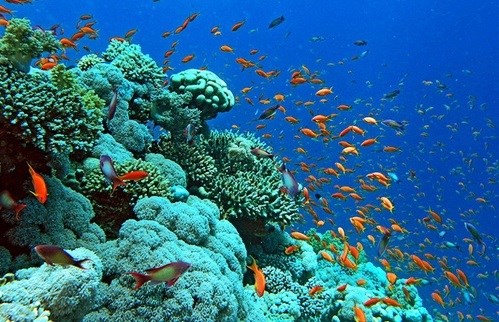Efforts to revive and protect coral reef ecosystems in Ha Long Bay

Coral ecosystem in Ha Long Bay. (Photo: baoquangninh.com.vn)
Hanoi (VNA) - The Ha Long Bay Management Board in the northern province of Quang Ninh is carrying various measures to protect coral reef ecosystems in the area.
Ha Long Bay is home to 147 species of coral. Areas with high coral coverage of over 30 percent are located in Cong Do-Tra San, Hang Trai-Dau Be with a total area of about 5,108 ha. Coral reefs are distributed mainly in Tra San, Soi Van and Luoi Liem areas.
To save the coral reef ecosystems in the bay, the management board has surveyed and built a database of the ecosystems useful for implementing conservation solutions. In addition, it has also trained human resources specialising in the management and protection of the coral reef ecosystems.
Patrols are regularly organised while violations in fishing and protection of aquatic resources are strictly handled.
The management board has regularly monitored and periodically supervised the conservation of coral reef ecosystems to promptly detect threats and carry out restoration measures.
Along with zoning off and strictly preserving coral reefs with high coverage from 30 percent or more, it also erected warning signs and has stopped boats from operating as well as increasing the frequency of inspections.
Activities to protect the water environment of Ha Long Bay have been enhanced to protect the habitat of coral reefs such as banning polluting acts or collecting floating waste, especially garbage at the foot of the islands where coral reefs are often distributed.
The Ha Long Bay Management Board, in collaboration with the municipal People's Committee of Ha Long city and related agencies have regularly launched dissemination campaigns and instructed vessels not to anchor on coral reefs and prevent fishing in prohibited areas.
 Ha Long Bay is home to 147 species of coral. (Photo
Ha Long Bay is home to 147 species of coral. (Photo
courtesy of Ha Long Bay Management Board)
Pham Dinh Huynh, Deputy Head of the Ha Long Bay Management Board, said thanks to the adoption of synchronised solutions, the coral reefs of Ha Long Bay are showing signs of recovery.
The number of coral reefs with coverage of over 60 percent and branched corals are growing, he said.
In 2019, Quang Ninh province issued a regulation on the management of Ha Long Bay, including a ban on fishing in the heritage area. This rule is of great significance for the conservation of coral reef ecosystems because fishing boats might cause environmental pollution, especially oil pollution, which is one of the main reasons for coral death.
Ha Long Bay, a UNESCO World Heritage Site located in Quang Ninh province, is one of Vietnam’s most popular travel destinations, receiving 14 million visitors in 2019.
Ha Long Bay literally “descending dragon” bay, was twice recognised as a World Natural Heritage site by UNESCO in 1994 and 2000. The bay spans 1,553 square kilometres and includes 1,969 islands of various sizes. It features thousands of limestone karsts and islets in various shapes and sizes.
The limestone in the bay has gone through 500 million years of formation in different conditions and environments. The geo-diversity of the environment has created biodiversity, including a tropical evergreen biosystem, oceanic and sea biosystem.
According to Deputy Chairman of the provincial People’s Committee Cao Tuong Huy, the province has outlined ways to increase its sea-based economy, focusing on tourism, sea services, and coastal industries that are environmentally friendly.
With a vision of becoming an international tourism centre with uniformed infrastructure, a kaleidoscope of high-quality tourism products, and a competitive edge over rivals in the region and the world, the province has invested heavily in tourism and trade facilities, developing eco-tourism in a sustainable manner, and forming high-end tourism sites in Ha Long, Van Don, Co To, Hai Ha Mong Cai, and Bai Tu Long.
The province will prioritise turning Ha Long into a modern tourism city while developing Van Don-Co To into an international entertainment centre. It is also studying how to develop new tourism products such as yachting, water taxis, seaplanes, hot air ballooning, and scuba diving. Due attention will be paid to upgrading local fishing ports and anchorages, improving fisheries logistics in Co To and Van Don districts, and forming three fishing centres in Co To, Van Don and Dam Ha, and two seafood trading centres in Ha Long city./.













